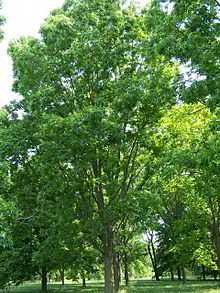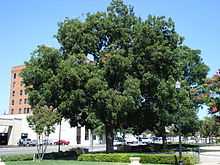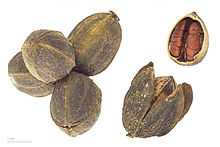Pecan
| Pecan | |
|---|---|
 | |
| Carya illinoinensis Morton Arboretum acc. 1082-39*3 | |
| Scientific classification | |
| Kingdom: | Plantae |
| (unranked): | Angiosperms |
| (unranked): | Eudicots |
| (unranked): | Rosids |
| Order: | Fagales |
| Family: | Juglandaceae |
| Genus: | Carya |
| Species: | C. illinoinensis |
| Binomial name | |
| Carya illinoinensis (Wangenh.) K.Koch | |
 | |
| Natural range of Carya illinoinensis | |
| Synonyms[1] | |
| |
The pecan (/pɪˈkɑːn/, /pɪˈkæn/, /ˈpiːkæn/, or /ˈpiːkɑːn/; Carya illinoinensis) is a species of hickory, native to south-central North America, in Mexico from Coahuila south to Jalisco and Veracruz,[1][2] in the United States in Alabama, Arkansas, Florida, Georgia, Illinois, Indiana, Iowa, Kansas, Kentucky, Louisiana, Mississippi, Missouri, Oklahoma, South Carolina, Tennessee, and Texas.
"Pecan" is from an Algonquian word, meaning a nut requiring a stone to crack.[3]
Growth


A pecan, like the fruit of all other members of the hickory genus, is not truly a nut, but is technically a drupe, a fruit with a single stone or pit, surrounded by a husk. The husks are produced from the exocarp tissue of the flower, while the part known as the nut develops from the endocarp and contains the seed. The husk itself is aeneous, oval to oblong, 2.6–6 cm (1.0–2.4 in) long and 1.5–3 cm (0.59–1.18 in) broad. The outer husk is 3–4 mm (0.12–0.16 in) thick, starts out green and turns brown at maturity, at which time it splits off in four sections to release the thin-shelled nut.[2][4][5][6]
The seeds of the pecan are edible, with a rich, buttery flavor. They can be eaten fresh or used in cooking, particularly in sweet desserts, but also in some savory dishes. One of the most common desserts with the pecan as a central ingredient is the pecan pie, a traditional southern U.S. recipe. Pecans are also a major ingredient in praline candy, most often associated with New Orleans.[7]
In addition to the pecan seed, the wood is also used in making furniture and wood flooring, as well as flavoring fuel for smoking meats.
Cultivation



Pecans were one of the most recently domesticated major crops. Although wild pecans were well known among the colonial Americans as a delicacy, the commercial growing of pecans in the United States did not begin until the 1880s.[8] Today, the U.S. produces between 80% and 95% of the world's pecans, with an annual crop of 150–200 thousand tons[9] from more than 10 million trees.[10] The nut harvest for growers is typically around mid-October. Historically, the leading pecan-producing state in the U.S. has been Georgia, followed by Texas, New Mexico and Oklahoma; pecans are also grown in Alabama, Florida, Arkansas, Kansas, Missouri, Arizona, South Carolina and Hawaii. Outside the United States, pecans are grown in Australia, Brazil, China, Israel, Mexico, Peru and South Africa. They can be grown approximately from USDA hardiness zones 5 to 9, provided summers are also hot and humid.
Pecan trees may live and bear edible seeds for more than 300 years. They are mostly self-incompatible, because most cultivars, being clones derived from wild trees, show incomplete dichogamy. Generally, two or more trees of different cultivars must be present to pollinate each other.
Choosing cultivars can be a complex practice, based on the Alternate Bearing Index and their period of pollinating. Commercial planters are most concerned with the Alternate Bearing Index, which describes a cultivar's likelihood to bear on an alternating years (index of 1.0 signifies highest likelihood of bearing little to nothing every other year).[11] The period of pollination groups all cultivars into two families: those that shed pollen before they can receive pollen (protandrous), and those that shed pollen after becoming receptive to pollen (protogynous).[12] Planting cultivars from both families within 250 feet is recommended for proper pollination.
Diseases
In the southeastern United States, nickel deficiency in C. Illinoinensis produces a disorder called mouse-ear in trees fertilized with urea.[13] An enzyme within the leaves uses nickel during the conversion of urea to ammonia, and a deficiency results in the toxic accumulation of urea. Symptoms of mouse-ear include rounded or blunt leaflet tips which produces smaller leaflets, dwarfing of tree organs, poorly developed root systems, rosetting, delayed bud break, loss of apical dominance, and necrosis of leaflet tips. Mouse-ear can be treated with foliar sprays of nickel.
A similar condition results from a zinc deficiency, which also can be treated by foliar sprays.[14]
Nutrition
| Nutritional value per 100 g (3.5 oz) | |
|---|---|
| Energy | 2,889 kJ (690 kcal) |
| Carbohydrates | 13.86 |
| - Starch | 0.46 |
| - Sugars | 3.97 |
| - Dietary fiber | 9.6 |
| Fat | 71.97 |
| - saturated | 6.18 |
| - monounsaturated | 40.801 |
| - polyunsaturated | 21.614 |
| Protein | 9.17 |
| Water | 3.52 |
| Vitamin A | 56 IU |
| - beta-carotene | 29 μg (0%) |
| - lutein and zeaxanthin | 17 μg |
| Thiamine (vit. B1) | 0.66 mg (57%) |
| Riboflavin (vit. B2) | .13 mg (11%) |
| Niacin (vit. B3) | 1.167 mg (8%) |
| Pantothenic acid (B5) | 0.863 mg (17%) |
| Vitamin B6 | 0.21 mg (16%) |
| Folate (vit. B9) | 22 μg (6%) |
| Vitamin C | 1.1 mg (1%) |
| Vitamin E | 1.4 mg (9%) |
| Vitamin K | 3.5 μg (3%) |
| Calcium | 70 mg (7%) |
| Iron | 2.53 mg (19%) |
| Magnesium | 121 mg (34%) |
| Manganese | 4.5 mg (214%) |
| Phosphorus | 277 mg (40%) |
| Potassium | 410 mg (9%) |
| Sodium | 0 mg (0%) |
| Zinc | 4.53 mg (48%) |
| Percentages are roughly approximated using US recommendations for adults. Source: USDA Nutrient Database | |
| This article is part of the series |
| American cuisine |
|---|
|
Regional cuisines Northeastern
Other |
|
Ingredients
|
|
Styles
|
|
Ethnic and cultural
|
|
Holidays and festivals
|
|
|
Pecans are an excellent source of manganese and a good source of protein and unsaturated fats. Like walnuts, pecans are rich in omega-6 fatty acids, although pecans contain about half as much omega-6 as walnuts.[15][16]
A diet rich in seeds can lower the risk of gallstones in women.[17] The antioxidants and plant sterols found in pecans reduce high cholesterol by reducing the "bad" LDL cholesterol levels.[18]
Clinical research published in the Journal of Nutrition (September 2001) found that eating about a handful of pecans each day may help lower cholesterol levels similar to what is often seen with cholesterol-lowering medications.[19] Research conducted at the University of Georgia has also confirmed that pecans contain plant sterols, which are known for their cholesterol-lowering ability.[20] Pecans may also play a role in neurological health. Eating pecans daily may delay age-related muscle nerve degeneration, according to a study conducted at the University of Massachusetts and published in Current Topics in Nutraceutical Research.[21]
Evolutionary development
The pecan, Carya illinoinensis, is a member of the Juglandaceae family. Juglandaceae are represented worldwide by between seven and 10 extant genera and more than 60 species. Most of these species are concentrated in the Northern Hemisphere of the New World, but can be found on every continent except for Antarctica. The first fossil examples of the family appear during the Cretaceous. Differentiation between the subfamilies of Engelhardioideae and Juglandioideae occurred during the early Paleogene, about 64 million years ago. Extant examples of Engelharioideae are generally tropical and evergreen, while those of Juglandioideae are deciduous and found in more temperate zones. The second major step in the development of the pecan was a change from wind-dispersed fruits to animal dispersion. This dispersal strategy coincides with the development of a husk around the fruit and a drastic change in the relative concentrations of fatty acids. The ratio of oleic to linoleic acids are inverted between wind- and animal-dispersed seeds.[22][23] Further differentiation from other species of Juglandaceae occurred about 44 million years ago during the Eocene. The fruits of the pecan genus Carya differ from those of the walnut genus Juglans only in the formation of the husk of the fruit. The husks of walnuts develop from the bracts, bracteoles, and sepals, or sepals only. The husks of pecans develop from the bracts and the bracteoles only.[23]
History
Before European settlement, pecans were widely consumed and traded by Native Americans. As a food source, pecans are a natural choice for preagricultural society. They can provide two to five times more calories per unit weight than wild game, and require no preparation. As a wild forage, the fruit of the previous growing season is commonly still edible when found on the ground. Hollow tree trunks, found in abundance in pecan stands, offer ideal storage of pecans by humans and squirrels alike.[10]
Pecans first became known to Europeans in the 16th century. The first Europeans to come into contact with pecans were Spanish explorers in what is now Mexico, Texas, and Louisiana. The genus Carya does not exist in the Old World. Because of their familiarity with the genus Juglans, these early explorers referred to the nuts as nogales and nueces, the Spanish terms for "walnut trees" and "fruit of the walnut." They noted the particularly thin shell and acorn-like shape of the fruit, indicating they were indeed referring to pecans.[10] The Spaniards took the pecan into Europe, Asia, and Africa beginning in the 16th century. In 1792, William Bartram reported in his botanical book, Travels, a nut tree, Juglans exalata that some botanists today argue was the American pecan tree, but others argue was hickory, Carya ovata. Pecan trees are native to the United States, and writing about the pecan tree goes back to the nation's founders. Thomas Jefferson planted pecan trees, Carya illinoinensis (Illinois nuts), in his nut orchard at his home, Monticello, in Virginia. George Washington reported in his journal that Thomas Jefferson gave him "Illinois nuts", pecans, which George Washington then grew at Mount Vernon, his Virginia home.
Breeding and breeding programs


Active breeding and selection programs are carried out by USDA-ARS[24] with growing locations at Brownwood and College Station, Texas. While selection work has been done since the late 1800s, most acreage of pecans grown today is of older cultivars, such as 'Stuart', 'Schley', 'Desirable', with known flaws but also with known production potential. The long cycle time for pecan trees plus financial considerations dictate that new varieties go through an extensive vetting process before being widely planted. Numerous examples of varieties produce well in Texas, but fail in the Southeastern U.S. due to increased disease pressure. Selection programs are ongoing at the state level, with Alabama, Arkansas, Georgia, Kansas, Florida, Missouri and others having trial plantings.
Varieties that are adapted from the southern tier of states up through some parts of Iowa and even into southern Canada are available from nurseries. Production potential drops significantly when planted further north than Tennessee. Most breeding efforts for northern-adapted varieties have not been on a large enough scale to significantly affect production. Varieties that are available and adapted (e.g., 'Major', 'Martzahn', 'Witte', 'Greenriver', and 'Posey') in zones 6 and farther north are almost entirely selections from wild stands. A northern-adapted variety must be grafted onto a northern rootstock to avoid freeze damage.
The pecan is a 32-chromosome species, and can hybridize with other 32-chromosome members of the Carya genus, such as Carya ovata, Carya laciniosa, and Carya cordiformis. Most such hybrids are unproductive, though a few second-generation hybrids have potential for producing hickory-flavored nuts with pecan nut structure. Such hybrids are referred to as "hicans" to indicate their hybrid origin.
Symbolism
In 1906, Texas Governor James Stephen Hogg asked that a pecan tree be planted at his grave instead of a traditional headstone, requesting that the seeds be distributed throughout the state to make Texas a "Land of Trees".[9] His wish was carried out and this brought more attention to pecan trees. In 1919, the 36th Texas Legislature made the pecan tree the state tree of Texas.
In Groves, Texas, the Texas Pecan Festival is celebrated every year. There is also an annual Pecan Festival in Colfax, Louisiana in the month of November. The North Carolina pecan harvest festival in Whiteville, NC is typically held on the first week of November. The town of Hickman, in western Kentucky, holds a pecan festival in September. The area is especially known for its wild seedling pecans. —The Brunswick Pecan Festival was first held in 1980, celebrating the large number of pecans being harvested in the area. It would become an annual tradition that continues each October.[25]
References
- ↑ 1.0 1.1 "Carya illinoinensis (Wangenh.) K. Koch". Germplasm Resources Information Network. United States Department of Agriculture. 2007-10-29. Retrieved 2009-10-15.
- ↑ 2.0 2.1 2.2 Flora of North America: Carya illinoinensis
- ↑ "History of Pecans - National Pecan Shellers Association". Ilovepecans.org. Retrieved 2010-06-03.
- ↑ Oklahoma Biological Survey: Carya illinoinensis
- ↑ Bioimages: Carya fruits
- ↑ Collingwood, G. H., Brush, W. D., & Butches, D., eds. (1964). Knowing your trees. 2nd ed. American Forestry Association, Washington, DC.
- ↑ "What is a Praline?". Pralines.com. Retrieved 2010-06-03.
- ↑ "Pecans at Texas A&M University". Pecankernel.tamu.edu. 2006-08-18. Retrieved 2010-06-03.
- ↑ 9.0 9.1 "Texas Pecan Growers Association". Tpga.org. Retrieved 2010-06-03.
- ↑ 10.0 10.1 10.2 Grant D. Hall. "Pecan Food Potential in Prehistoric North America". Economic Botany (New York Botanical Garden Press). JSTOR 4256253.
- ↑ "University of Georgia Pecan Breeding". Cpes.peachnet.edu. Retrieved 2010-06-03.
- ↑ "William Reid, Nut Crops Extension Specialist, University of Illinois". Retrieved 2010-06-03.
- ↑ Allen V. Barker; D. J. Pilbeam (2007). Handbook of plant nutrition. CRC Press. pp. 399–. ISBN 978-0-8247-5904-9. Retrieved 17 August 2010.
- ↑ http://attra.ncat.org/attra-pub/pecan.html
- ↑ "Nuts, pecans". Nutrition Facts. Nutrition Data. Retrieved 2009-10-09.
- ↑ "Nuts, walnuts, english [Includes USDA commodity food A259, A257]". Nutrition Facts. Nutrition Data. Retrieved 2009-10-09.
- ↑ "Frequent nut consumption and decreased risk of cholecystectomy in women - Tsai et al. 80 (1): 76 - American Journal of Clinical Nutrition". Ajcn.org. Retrieved 2010-06-03.
- ↑ "LLUAHSC - Spring 2002 Newscope". Llu.edu. 2009-06-01. Retrieved 2010-06-03.
- ↑ "TODAY - September 20, 2001 - LLU news". Llu.edu. 2009-06-01. Retrieved 2010-06-03.
- ↑ "Pecans: Cholesterol Lowering Source of Antioxidants, Fiber, Vitamin E, Protein". Ilovepecans.org. Retrieved 2010-06-03.
- ↑ "Pecans: Handful a Day Keeps Aging at Bay". UPI.com.
- ↑ Donald E. Stone, et al. "New World Juglandaceae. II. Hickory Nut Oils, Phenetic Similarities, and Evolutionary Implications in the Genus Carya". American Journal of Botany (Botanical Society of America). JSTOR 2440634.
- ↑ 23.0 23.1 Paul Manos and Donald E. Stone (Spring 2004), "Evolution, Phylogeny, and Systematics of Juglandaceae", Annals of the Missouri Botanical Gardens (Missouri Botanical Garden Press), Vol. 88 (No. 2)
- ↑ USDA Pecan Breeding Program, National Clonal Germplasm Repository for Pecans and Hickories
- ↑ Brunswick, Missour
External links
| Wikimedia Commons has media related to Carya illinoinensis. |
- National Pecan Shellers Association
- Carya illinoinensis images at bioimages.vanderbilt.edu
- National Center for Home Food Preservation — Home Preservation of pecans
- USDA Forest Service: Carya illinoensis
- Interactive Distribution Map of Carya illinoensis
- The Pecan and its Culture at Project Gutenberg (Text from 1906)
| ||||||||||||||